It is literally a transparent window made of yttria-stabilized zirconia (YSZ), which we envision to become a suitable cranial implant that allows physicians for optical access to the tissue brain. It would serve the same mechanical function of current cranial implants made of other materials, such as titanium, except that it would enable optical access too, which could be very beneficial for post-operatory diagnostic or therapeutic procedures.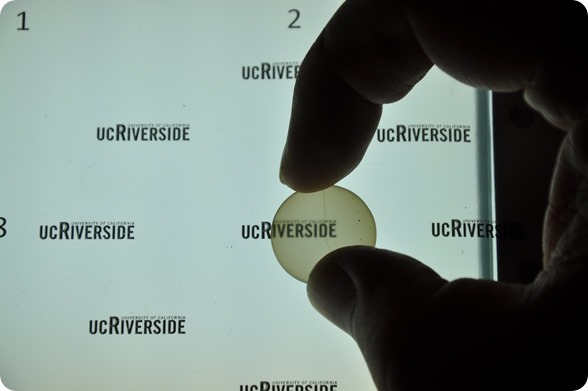
It is made from nanocrystalline powder of yttria-stabilized zirconia (YSZ) and densified using a novel process known as Current Activated Pressure Assisted Densification (CAPAD), developed by my colleague Prof. Javier E. Garay. The reason this implant is transparent is because through CAPAD, the ceramic powder can be densified at rapid heating rates, maintaining the nanometric scale of its polycrystalline structure.
We are investigating the biocompatibility of this particular kind of YSZ as an implant for this particular anatomic location (cranium), but we are fairly certain that it will prove to be safe, since it has already been used extensively in other biomedical applications, such dental implants and hip replacements, albeit not in this particular polycrystalline nanostructured form.
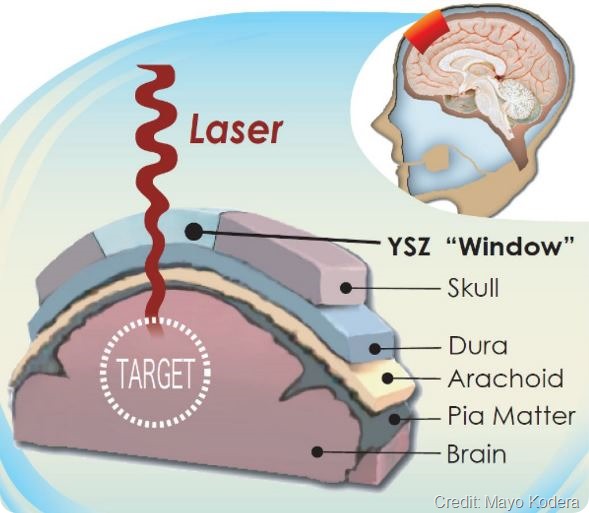
A cross section of the head that shows how the transparent skull implant works.
How were laser-based treatments for brain disorders previously performed? What impact do you hope the implant will have on the treatment of neurological disorders?
That is a key issue. Since the skull is too thick and opaque to essentially all laser wavelengths, there are no brain disorders, to my knowledge, that are currently treated with lasers. However, having an optical window of this kind would provide clinically-viable means for optically accessing the brain, on-demand, over large areas, and on a chronically-recurring basis, without need for repeated craniectomies.
It is foreseeable, for example, that recurring photo-dynamic therapies (PDT) of remnant malignant brain tissue could be performed through a YSZ window placed on the skull of the affected patient after a craniectomy for brain tumor resection. Likewise, traumatic brain injury (TBI) patients could be subjected to continuous laser-based diagnostic or even therapeutic procedures to track the progression of the affected region of their brain.
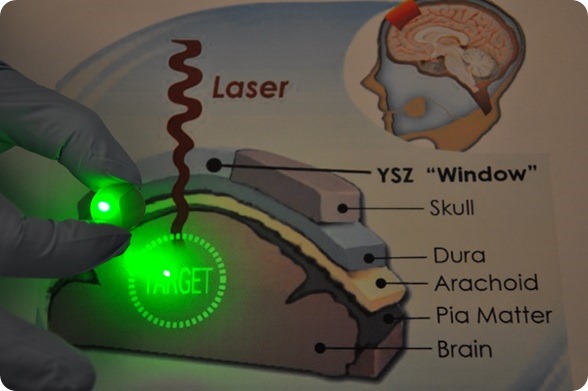
A laser beam going through the transparent implant to a print out of the brain illustration.
How does this work relate to President Obama's recently-announced BRAIN (Brain Research through Advancing Innovative Neurotechnologies) Initiative?
We know this is a very ambitious initiative, and many researchers including ourselves are still trying to wrap our heads around it, so to speak, but regardless of what innovative neurotechnologies this initiative brings about, the majority of them will need some way of visualizing the brain, so these windows could become an enabling technology that facilitates the clinical translation of promising brain imaging and neuromodulation technologies being developed under this initiative.
How does the transparent skull implant you have developed differ from previous transparent skull implants?
As mentioned before, current cranial implants provide biocompatibility and mechanical stability, but are not transparent. YSZ implants of this kind are also expected to be biocompatible (as they already are for other medical applications), they are very hard materials, but they’re also transparent, which is something no other implant offers. This optical capability alone is a crucial first step towards an innovative new concept that would provide a clinically-viable means for optically accessing the brain, on-demand, over large areas, and on a chronically-recurring basis.
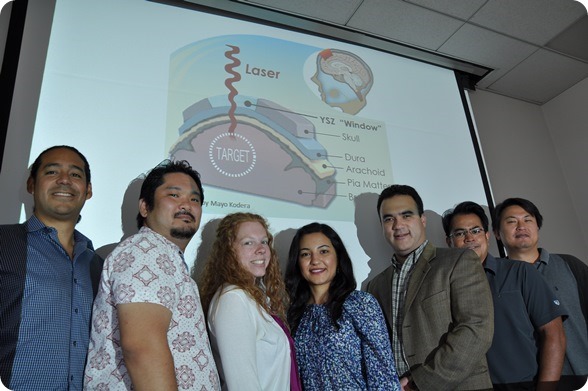
Members of the research team, from left, Javier Garay, Yasuhiro Kodera, Carissa L. Reynolds, Yasaman Damestani, Guillermo Aguilar, Masaru P. Rao and B. Hyle Park.
What excites you most about your current research and what are your further research plans?
There are many challenges ahead of us, which makes this whole venture very exciting in almost any way we look at it. The breakthrough thus far has been to develop this material and show that we can enhance the optical imaging of a live animal brain far better than we would through the native skull. Now, we need to show the material is biocompatible for this particular anatomic location. In this regard we need to assess its osseointegration and soft tissue encapsulation; we also need to conduct detail mechanical tests to ensure this implant could indeed be a comparable or even better substitute of current implant materials; we also need to solve the issue of rendering the scalp transparent on a temporary basis for recurring therapies; we may also want to shape the implant into intricate forms or even write waveguides across its thickness to deliver coherent laser light across the implant. All these are concurrent issues we’re exploring and all of them are exciting.
UCR: Researchers develop window to the brain
What do you think the future holds for treatments for neurological disorders?
It is hard to generalize about the future of all neurological disorders, particularly from our perspective, but I certainly hope that a window like this helps, at least in some way, other scientists to study the pathogenesis of many neurological diseases and physicians to diagnose and treat them in a less invasive and more successful way.
Where can readers find more information?
They can find some more information on the UCR website, the Bourns College of Engineering (BCOE) Website, and the Department of Mechanical Engineering website (links below)
They may also found out more about the work the whole group does in our respective websites:
About Professor Guillermo Aguilar
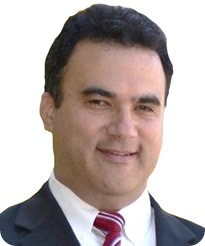 Prof. Guillermo Aguilar received his B.S. in Mechanical and Electrical Engineering from the National Autonomous University of Mexico (UNAM) in 1993. He earned his M.S. and Ph.D. also in Mechanical Engineering at the University of California Santa Barbara (UCSB) in 1995 and 1999, respectively. In 1999, he received a Whitaker Postdoctoral Fellowship to join the Beckman Laser Institute and the former Department of Chemical and Biochemical Engineering and Material Sciences (CBEMS) at the University of California Irvine (UCI).
Prof. Guillermo Aguilar received his B.S. in Mechanical and Electrical Engineering from the National Autonomous University of Mexico (UNAM) in 1993. He earned his M.S. and Ph.D. also in Mechanical Engineering at the University of California Santa Barbara (UCSB) in 1995 and 1999, respectively. In 1999, he received a Whitaker Postdoctoral Fellowship to join the Beckman Laser Institute and the former Department of Chemical and Biochemical Engineering and Material Sciences (CBEMS) at the University of California Irvine (UCI).
Since 2003 Prof. Aguilar joined the Department of Mechanical Engineering (ME) at University of California Riverside (UCR), where he was promoted to Associate Professor in 2007 and Full Professor in 2012. Prof. Aguilar served as the Graduate Advisor and Chair of the Graduate Committee of the ME Department from 2005-2010 and 2011-2012 and currently serves as the Department Chair.
Prof. Aguilar has co-authored more than 70 journal publications, advised more than 40 students, including 17 graduate students (MS and PhD) and several undergraduate students and interns. He has received research funding from various sources, including NSF, ASLMS, AFOSR, Sandia National Labs, and NIH. His research interests include cryogen spray atomization, spray cooling, laser-tissue interactions, and combined use of cryogenics and lasers for biomedical applications.